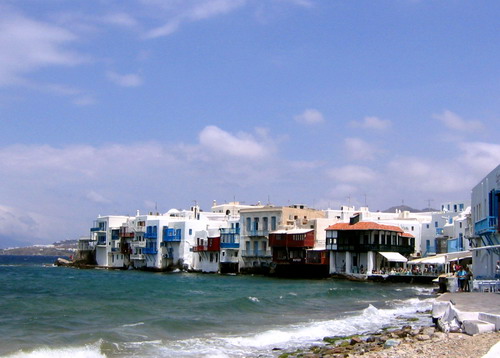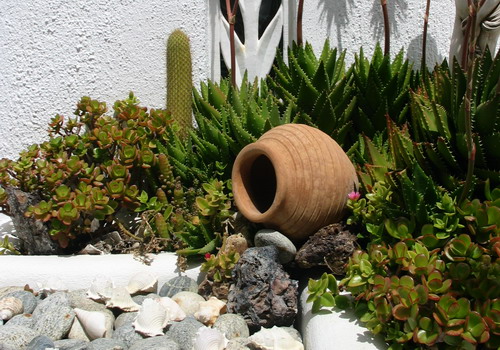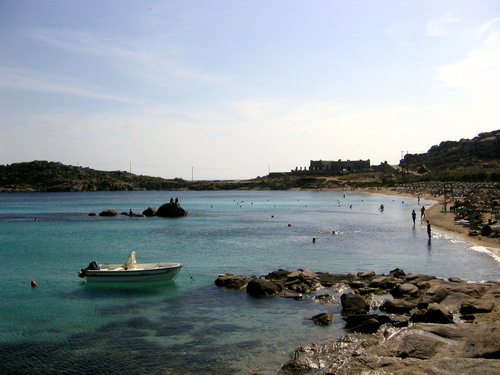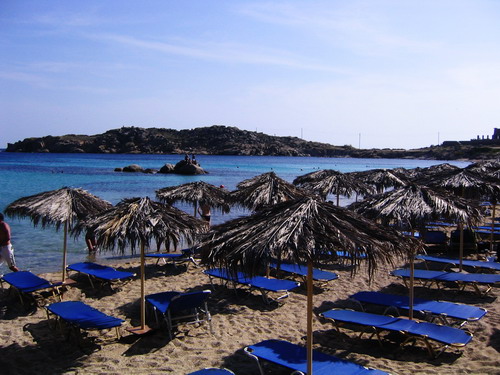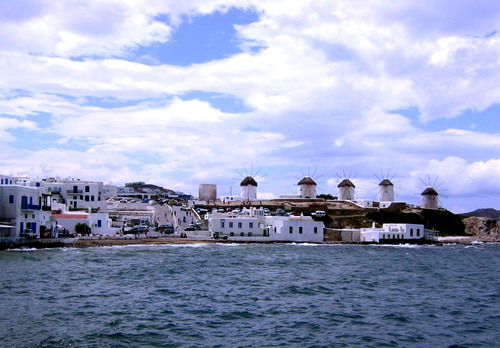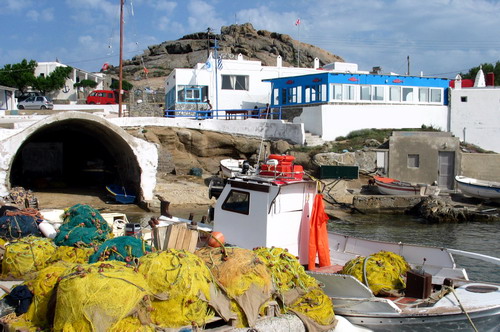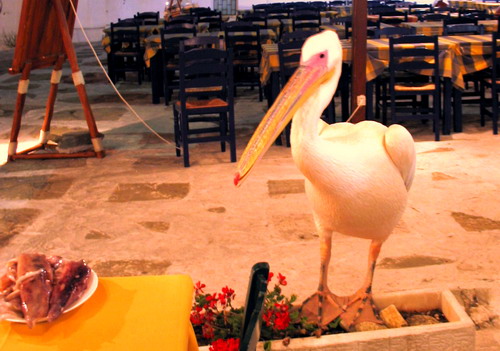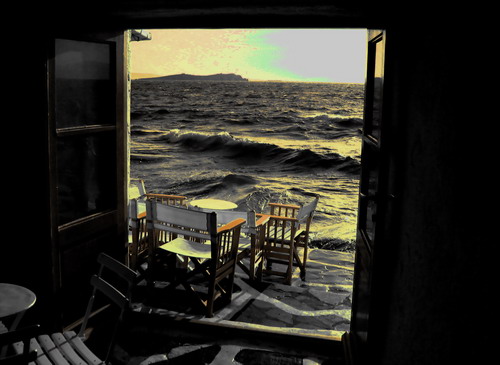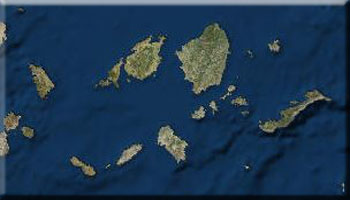Delos
The sacred island of the ancient Greeks, Delos, in mythology, was raised from the Aegean surf by the sea-god Poseidon to offer shelter to Leto who was pregnant with Apollo and Artemis and being persecuted by Hera. Delos is remarkable for its preserves, in quite good condition, one of the most impressive organized ancient settlements. First inhabited in the third millennium B.C., most likely by the Carians, the island by the tenth century B.C. had emerged as a religious center and seat of the Great Amphictyony. In the late sixth century B.C., the island was under Athenian rule. In 540 B.C. Peisistratus orders the first "cleansing" of the island, while during the second, in 426 B.C., the remains of all the dead of Delos were transferred to neighboring Rineia; births and deaths on the island are banned from this point forward to preserve the sanctity of Apollo's temple.
With the arrival of the Macedonians in 315 B.C., the island attains independence and the ability to develop commercially. Later, the Romans' presence attracted the Egyptians, Syrians, and Italians, spurring the island's growth even more; in 88 B.C., during the raids by Mithridates wars, the island suffers two devastating attacks that push it into decline and lead to its eventual abandonment in the sixth century B.C. Excavations on the island were begun in 1873 by the French Archaeological School, which brought to light the extensive ruins of this once-glittering center. The Delos Archaeological Museum is one of the most important archaeological sites in Greece. Delos and Rineia are protected by the Ministry of Culture and anchorage or overnight stays are not allowed without authorization.
Drafaki, Vrysi, Glastros, Plati Yialos
Several small yet interesting monuments are scattered south of Hora in areas that until recently were farm land. At Drafaki (Paspari) there are number of old but well-preserved chapels. At Vrysi, a Mycenaean tholos tomb-an unusual find for the Cyclades-was uncovered a few years ago, yielding interesting funds that attest to the island's relations with mainland Mycenaean culture. In the same area, one can see wonderful dovecotes in old gardens.
Throughout the countryside, ruins of a ancient square or round towers are visible, presumably remnants of some ancient fortification system. The tower at Lino has a 10-meter diameter, while the tower at Portes, overlooking Platis Yialos, has a smaller diameter of just 3.5 meters but its impressive threshold is preserved. Several ancient wells are also still in use, among them Yiannaros's well, an underground cistern built of granite blocks with a stepped aqueduct. The Pouados is framed by steps for easy access and is located below the rim of the Tourlou-Korfos road at Tagou.
Little Venice
This picturesque quarter with its brightly colored balconies and wood boudia seems to hover over the sea between Kastro and Skarpas. It's an excellent spot for enjoying one of the most beautiful sunsets in Greece.
Paraportiani Church
Paraportiania is a distinctive architectural compound that is the result of human creation and the forces of time and nature. Paraportiani's name derives from its location next to the northwestern side entrance, or paraporti, of the island's medieval walls. It's actually a two-story compound of five churches-four on the ground floor and a fifth built over them. It's the one on top that is actually Panayia Paraportiani, and was built between the 16th and 17th centuries. Thanks to the compound's unique architecture, it is recognized as an important monument not just on Mykonos but throughout the Aegean.
Zoodohos Piyi (Cathedral), Panahra, Ayia Kyriaki, Ayios Nikolaos Yialou, Ayia Eleni
These churches are just some of Hora's most important post-Byzantine churches, each boasting interesting icons and carefully crafted iconostasis. The large number of votives seen in most churches are part of the locals' custom of interring their ancestors' remains in church walls.
Kalafatis-Divounia
Traces of an Early Cycladic acropolis are visible at the twin cove of Divounia-Tarsanis at Kalafatis, southeast of Ano Mera.
Kato Myloi
A row of seven windmills - of the original ten - rises on a low ridge south of Hora, between picturesque Alefkantra and the Niohori, looking out to sea and creating the image most visitors associate with Mykonos.
Ftelia - Poros
Prehistoric ruins have been identified around the island, for example at Panormos, the most important being the Neolithic settlement at Ftelia. The same site has been associated in archaic times with the grave of Aias of Locris, a hero of the Trojan war who was worshipped on Mykonos.
Panayia Tourliani Monastery
Founded in 1542 on the site of an older church dedicated to the Presentation of the Virgin. From 1757 to 1767, the monastery, which is dedicated to the Dormition of the Virgin, was renovated by the Monk Ignatios Basoula to its present form. The triple-apsed church is noted for its iconostasis, carved from wood in the Baroque style, its throne, and its late-18th century altar-all of which tradition holds were crafted in Florence. Inside there are also icons by Ioannis of Corfu.
Palaiokastro Monastery
This 18th-century convent is a typical example of Cycladic monastic architecture. Located north of Ano Mera, it is named after the neighboring hill-Palaiokastro-that is crowned by a medieval castle, which was subsequently renovated by the Gyzis brothers. Nearby sights include the church of Ayios Vlassis and a large dovecote as well as a prehistoric grave comprised of a three-meter-high granite boulder.
Municipal Library
Most of the library's 10,000 - volume - strong collection is from the library of Alexandros Meletopoulos. It includes a collection of photographs, 18th- and 19th-century documents, etchings and other items. The library is located in the Ayia Kyriaki quarter of Hora and is housed in the 18th-century Kambanis mansion.
Panayia Lozaria
Located on Alefkantra square, the church is marked by the Bourbon shield on the faade. It was built during the reign of Louis XIV.
Marathi - Ampelokipos
Two more noteworthy examples of church architecture are Ayios Pandeleimonas at Marathi, which is typical of 17th-century religious architecture with fine icons and murals, and the late-17th-century Ayios Yeoryios at the Ampelokipos district of Ano Mera.
Tria Pigadia
Three wells located at Tria Pigadia in Hora which supplied Hora with water from the 18th century through the Fifties.
Town Hall
The elegant two-story building with the clay-tile roof was built in 1780 during the Orlof uprising and served as the headquarters of the Russian consul general. The building subsequently passed into the hands of the local self-governing authority and today houses the Town Hall and its services. The adjacent building, the imposing Mavros mansion, was the island's first public school. It was built in 1859 during the reign of King Othon (Otto) to designs by the Bavarian engineer Weiller.









